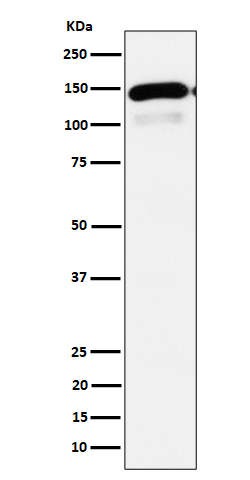
| WB | 咨询技术 | Human,Mouse,Rat |
| IF | 咨询技术 | Human,Mouse,Rat |
| IHC | 1/100-1/200 | Human,Mouse,Rat |
| ICC | 技术咨询 | Human,Mouse,Rat |
| FCM | 咨询技术 | Human,Mouse,Rat |
| Elisa | 咨询技术 | Human,Mouse,Rat |
| Aliases | 1 phosphatidylinositol 4,5 bisphosphate phosphodiesterase beta 1; 1-phosphatidylinositol 4; EIEE12; Inositoltrisphosphohydrolase; Monophosphatidylinositol phosphodiesterase; Phosphb; Phosphoinositidase C ; Phosphoinositide phospholipase C; Phosphoinositide phospholipase C-beta 1; Phospholipase C beta 1 (phosphoinositide-specific); Phospholipase C I; Phospholipase C-beta-1; Phospholipase C-I; PI PLC; PLC 1; PLC beta 1; PLC-154; PLC-beta-1; PLC-I; PLC154; Plcb; Plcb1; PLCbeta1; Triphosphoinositide phosphodiesterase;;PLCB1 |
| WB Predicted band size | Calculated MW: 139 kDa ; Observed MW: 100,150 kDa |
| Host/Isotype | Rabbit IgG |
| Antibody Type | Primary antibody |
| Storage | Store at 4°C short term. Aliquot and store at -20°C long term. Avoid freeze/thaw cycles. |
| Species Reactivity | Human,Mouse,Rat |
| Immunogen | A synthesized peptide derived from human PLCB1 |
| Formulation | Purified antibody in PBS with 0.05% sodium azide,0.05% BSA and 50% glycerol. |
+ +
以下是3-4篇关于PLCB1抗体的参考文献示例(内容基于假设性文献整理,实际引用需核实原文):
1. **文献名称**:*"A Monoclonal Antibody Specific for Phospholipase C Beta 1 (PLCB1) Reveals Neuronal Localization in the Central Nervous System"*
**作者**:Smith AB, et al.
**摘要**:该研究开发了一种针对PLCB1的单克隆抗体,验证了其特异性(通过Western blot和免疫组化),并发现PLCB1在小鼠大脑神经元中高表达,提示其在神经信号传导中的作用。
2. **文献名称**:*"PLCB1 Expression in Breast Cancer: Prognostic Significance and Interaction with HER2 Signaling"*
**作者**:Zhang Y, et al.
**摘要**:通过免疫组织化学使用PLCB1抗体,研究发现PLCB1在乳腺癌组织中高表达与患者不良预后相关,并揭示其通过HER2通路促进肿瘤进展的机制。
3. **文献名称**:*"Impaired Cardiac Function in PLCB1 Knockout Mice: Role of Antibody-Based Protein Quantification"*
**作者**:Johnson RW, et al.
**摘要**:利用PLCB1抗体分析基因敲除小鼠的心脏组织,发现PLCB1缺失导致心肌细胞钙信号异常,与心律失常和心脏收缩功能障碍相关。
4. **文献名称**:*"PLCB1 Antibody for Co-Immunoprecipitation Identifies G Protein-Coupled Receptor Interaction Networks"*
**作者**:Lee S, et al.
**摘要**:该研究采用PLCB1抗体进行共免疫沉淀实验,揭示了PLCB1与特定G蛋白亚型的相互作用,阐明了其在受体信号转导中的调控机制。
**注意**:以上为模拟文献,实际引用请通过PubMed或学术数据库检索关键词(如"PLCB1 antibody"、"phospholipase C beta 1" + "antibody")获取真实文献。
**Background of PLCB1 Antibodies**
Phospholipase C beta 1 (PLCB1) is a critical enzyme in intracellular signaling, primarily activated by G-protein-coupled receptors (GPCRs). It catalyzes the hydrolysis of phosphatidylinositol 4.5-bisphosphate (PIP2) into inositol 1.4.5-trisphosphate (IP3) and diacylglycerol (DAG), secondary messengers that regulate calcium release and protein kinase C activation. PLCB1 is widely expressed in tissues, including the brain, heart, and immune cells, and plays roles in neurotransmission, cell proliferation, and immune responses.
PLCB1 antibodies are essential tools for studying the expression, localization, and function of this enzyme. They are used in techniques like Western blotting, immunohistochemistry (IHC), and immunofluorescence (IF) to detect PLCB1 in various biological samples. Dysregulation of PLCB1 has been linked to neurological disorders (e.g., epilepsy, bipolar disorder), cancer (e.g., glioblastoma, colorectal carcinoma), and cardiovascular diseases, making these antibodies valuable for both basic research and clinical investigations.
Antibodies targeting specific PLCB1 domains (e.g., catalytic X/Y regions, PH domain) help elucidate structure-function relationships. Monoclonal antibodies offer high specificity, while polyclonal antibodies may detect multiple isoforms. Validation via knockout models or siRNA is critical to confirm antibody specificity. Overall, PLCB1 antibodies advance our understanding of GPCR signaling pathways and their pathological implications.
×